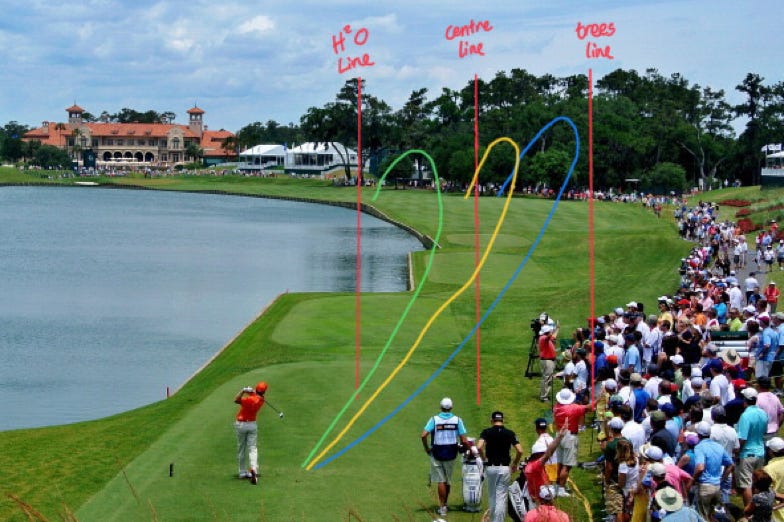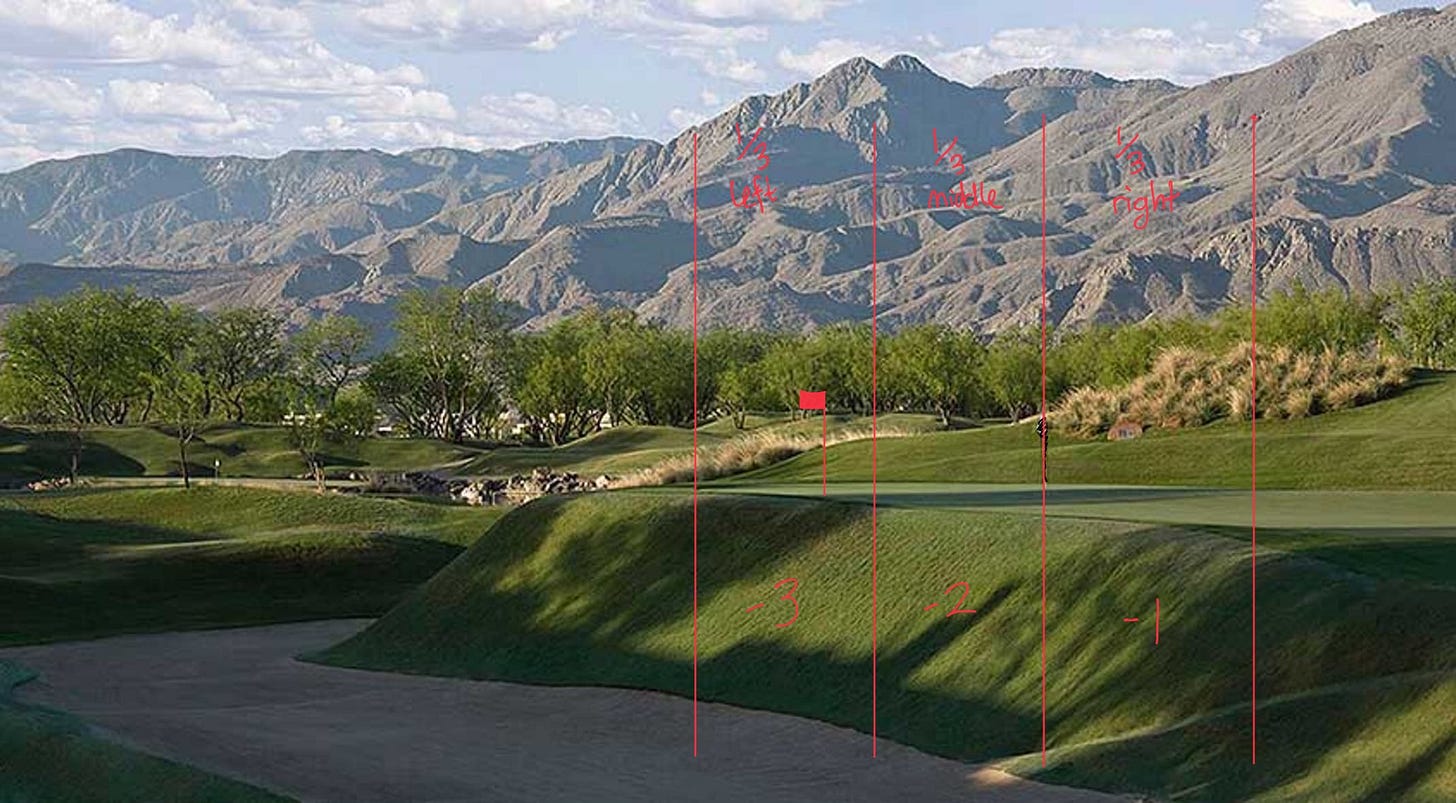Put The Odds In Your Favour: DECADE For Beginners.
Full Content
When it comes to actually PLAYING golf, very few things matter as much as sound strategy. What I want to cover in this piece is how to put the odds in your favour, I will explain the simple numbers behind how playing it “safe” can actually help you win more often.
For those that don’t know, the system DECADE was created by an American guy named Scott Fawcett. It is first and foremost a statistics program but it comes with a very sound method for choosing targets. I want to go over those two methods here, one is for tee shots and one is for approach shots.
First, Tee Shots. Hitting the ball as far down a hole while keeping it in play is literally goal number one when your stand on a tee, or at least it should be. That is why this very simple method is so useful, avoiding hazards and lost balls is of pinnacle importance to good golf.
When it comes to avoiding hazards, there is a hierarchy here, in order; you must avoid;
Out Of Bounds at all costs.
Water Hazards next
Potential Lost Balls (thick trees etc)
Deep Rough is next
and finally Fairway Bunkers.
When you stand on a tee, you have to make these kinds of determinations, and avoid the worst of the options. A tee shot with Out Of Bounds on the left and a Water Hazard on the right has to be played down the right-centre of the fairway. A tee shot with Deep Rough down the right, and Fairway Bunkers on the left has to be hit down the left understanding that you are simply taking the worst option out of play and that’s the best you can do.
This is a very simple way to improve your scores, golf is about always making the best of every situation, sometimes that means making birdie, sometimes making bogey is more of an achievement. That means that if you turn a potential 7 into a 5, you have actually done more for your round than getting lucky and turning a 4 into a 3. Don’t forget the aim of the game is to have the lowest score, not simply make the most birdies, although that does help.
Now how does this apply to your golf, your course? Well it’s fairly simple to stand on a tee and decide which side is better, and there is always a better option. All you have to do is choose which side is better, and play down the middle of that half of the fairway. You will avoid big numbers by simply being in play more, no matter your skill level this is sensible. You may not perfectly execute but you will be well on your way to good strategy.
Look below at a famous tee shot I have broken down, the 18th Tee Shot at TPC Sawgrass. I am assuming we all can see that hitting a draw here is optimal. So our three lines; water, centre and tree are drawn in red.
The correct line here is to split the two on the right, shown in blue. The aggressive line is to go straight down the centre shown in yellow, and the Stupid line is to take it down the left shown in green. Stupid because you only increase you’re chances of making birdie slightly, and your chances of making bogey or double-bogey are increased exponentially, making it a bad bet.
Ok lets move on to second shots. This in my opinion, is where DECADE really has an incredible impact. There are simple probabilities at work, and they are totally counterintuitive, which makes them extremely difficult to follow.
So when should you fire straight at a flag? How aggressive should you be? When should you play it safe? When should you lay-up? When should you go for it? Well the answer to all these questions is; it depends.
Depends on what?? It depends on what hazards are around the green, and how close the flag is to them. There is a great simple system here. But let me first explain why this matters with some simple numbers.
Let’s assume you play a single pin-position 30 times. Say over the course of a year at your home club? Or over 3 months on tour. We can all agree that the best possible goal here is to have the lowest average score over those 30 times. Let’s add a couple more assumptions to get my point across:
When your miss a green, lets assume you get up and down 50% of the time.
When you’re inside of 10ft, you make the putt 30% of the time.
When you’re outside of 10ft, you make the putt 20% of the time, and 3-putt 10% of the time.
Lets also assume, that your shot pattern will be even; 1/3 left, 1/3 right and 1/3 straight.
Ok, so lets assume you’re hitting to a green with a left pin tucked to a deep bunker. The 16th at PGA West is timely as the American Express was there this past week.
Ok so the 10 shots we hit left (1/3 off 30 times played) we make 5 pars, and 5 bogeys. That puts us at +5 for those 10.
The 10 we hit in the middle, we make 7 pars and 3 birdies, so we are -3 for these 10.
The last 10, we made 8 pars, 2 birdies and 1 bogey. So we are -1
That’s puts us at a total of +1 (+5 -3 -1 = +1)
Ok so lets assume that we shift our target to be right of the flag, towards the centre of the green and see what that does to our shot pattern.
Ok so now our left 1/3 is giving us birdies, as above we hole 30% of the shots we hit inside 10ft, so we are -3 for these 10.
Seeing as our middle 1/3 now falls half inside 10ft and half outside 10ft we get 5 of each;
5 times we make birdie 30% of the time (5 x 30% = 1.5) so we are -1.5 for these.
The other 5 we average 1/10 making holing our putts (20% holed and 10% 3-putted = 1/10 holed) so 5 x 10% = 0.5 so we are -0.5 for these 5.
So together we are -2 for these 10.
The right 1/3 we are holing the putts 20% of the time and 3-putting 10% of the time, so we make 1 bogey and 2 birdies so we are -1.
Out average score for this shot pattern is now -6 (-3 -2 -1 = -6)
That is 7 shots better than the “aggressive” one.
But how do you apply this easily?
Well like this; your bag has three easily sections; Long Clubs (woods/utilities), Middle Clubs (long-irons, mid-irons) and Short Clubs (short-irons, wedges).
This is how you break it down:
When you have a Long Club aim 12 meters from trouble.
When you have a Middle Club aim 9 meters from trouble
When you have a Short Club aim 6 meters from trouble.
The other way to think about this is:
When you have a Long Club aim 4 Flagsticks from trouble.
When you have a Middle Club aim 3 Flagsticks from trouble
When you have a Short Club aim 2 Flagsticks from trouble.
So as you can see below, with a Long Club your target is the Green Arrow, with a Mid Club your target is the Blue Arrow, and a Short Club your target is the Red Arrow.
If you can stick to these two rules. Tee shots avoiding major trouble, and making sure you have the odds working for you with approach shots; I can guarantee you will score better.
Ps if it feels difficult to do that just means you’re doing it right!
Name That Track!!
Answer will follow next Monday!
Thanks for reading, and Happy Golfing!
BM







